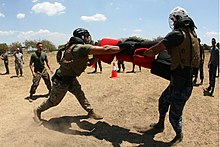Pugil stick
Pugil stick ( Latin - English : pugilist stick or boxer Stock ) is an originally States United Marine Corps introduced training device for bayonet fighting .
description
The Pugil stick is a stick similar to the Japanese Bō , which was originally only wrapped with fabric at both ends to simulate a rifle with a bayonet attached. In the present it is a cheap exercise device , with which real rifles are protected and the risk of injury for the exercises, as far as known, is relatively low. The device has a padded casing with which the rifle butt and bayonet are simulated. The practitioners wear protective equipment similar to American football players.
history
The inventor of the pugil stick is considered to be Armond Harold Seidler (1919–2017), who did his doctorate on hand-to-hand combat techniques at the University of Illinois . Apparently the device was introduced to the Marine Corps at the beginning of World War II in the Pacific region around 1942. The roots are apparently in Japanese Bōjutsu and the medieval English quarterstaff (quarterstaff or fighting staff , see German fencing school ).
In the early 1990s, the device was popularized by the American Gladiators television show . In 2010 the United States Army removed it from the exercise program because it was allegedly out of date. In 2011, members of the Fuerzas Armadas de Nicaragua in Corinto were trained on the device by a commission of the Marines.
literature
- Leo J. Daugherty III: Counterinsurgency and the United States Marine Corps. Volume 1, The First Counterinsurgency Era, 1899-1945 , Jefferson, NC 2015. ISBN 978-0-7864-9698-3
- Armond H. Seidler: Defend Yourself: Scientific Personal Defense , Houghton Mifflin Harcourt 1978. ISBN 978-0395258224 . 2nd ed. Kendall Hunt Pub Co 1990. ISBN 978-0840362971


